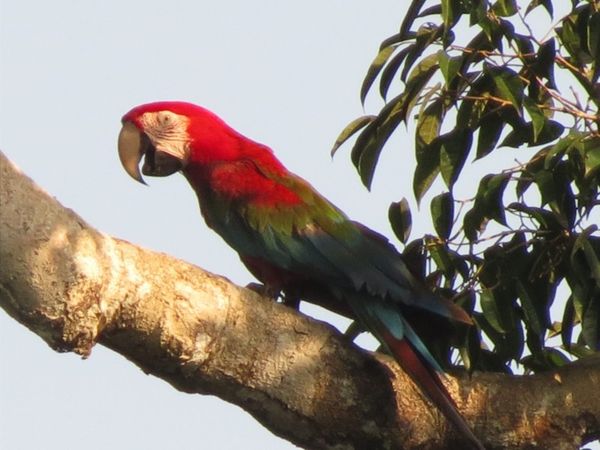Are tiny sensors better per square mm?
Mar 19, 2014 12:26:35 #
Why is it that a camera manufacturer selling cameras with a tiny 1/2.3 sensor with 10 MP, and also sells full frame cameras (with 30X the image area) that are only 24MP?
Mmm, pondering tiny point-and-shoot 1/2.3 sensors are 6.2x4.6mm=28.52 Sq mm. A full frame is 36×24mm =864 Sq mm, which is 30.29 times the area of the small sensor. Why isnt the pixel count of a full frame camera not 30X the 10 MP of the small sensor for a total of a 300 megapixel camera?
Yes, Ive heard that the better full frame cameras have sensors with bigger pixels that each do a better job of soaking up light and color than tiny pixels can, and maybe that is the answer,
BUT In this era of marketing your products, why wouldn't a manufacturer produce a 300 megapixel full-frame camera?
Am I missing anything here?
Mmm, pondering tiny point-and-shoot 1/2.3 sensors are 6.2x4.6mm=28.52 Sq mm. A full frame is 36×24mm =864 Sq mm, which is 30.29 times the area of the small sensor. Why isnt the pixel count of a full frame camera not 30X the 10 MP of the small sensor for a total of a 300 megapixel camera?
Yes, Ive heard that the better full frame cameras have sensors with bigger pixels that each do a better job of soaking up light and color than tiny pixels can, and maybe that is the answer,
BUT In this era of marketing your products, why wouldn't a manufacturer produce a 300 megapixel full-frame camera?
Am I missing anything here?
Mar 19, 2014 13:14:37 #
1, NO, they are worse in every aspect.
2, Because bigger pixels are better.
3, you are correct
4, The camera would need a trailer?! :lol:
SS
2, Because bigger pixels are better.
3, you are correct
4, The camera would need a trailer?! :lol:
SS
Mar 19, 2014 13:29:24 #
amehta
Loc: Boston
PTphoto wrote:
Why is it that a camera manufacturer selling camer... (show quote)
The Canon and Nikon top-of-the-line cameras (1DX and D4s) have fewer mp than the Nikon entry-level camera (D3300). Bigger is better, but what should be bigger?
Another factor is the processing power needed to handle more and more mp, both on the camera and on the computer.
The cost of the chip would also go up a lot. It costs a lot more to fabricate a large chip than a small one, and it costs more to make the smaller pixels.
Mar 19, 2014 15:32:43 #
Thanks, SharpShooter and amehta.
Makes sense, now lets add another twist with the lens part of the equation.
On my recent Amazon trip, our guide took pics with his small and light Canon PowerShot SX40 HS with its 24-840mm lens. I used a bigger heavier Nikon D600 with the Nikkor 28-300mm. Below are the pics we each took of the same Hoatzin bird, and Red and Green Macaw, each some 500 ft away.
We were both fully zoomed out. His super-zoom lens is 2.8 times the focal length of mine, so I assume the image on his sensor was 2.8 times larger than the image on my sensor.
I think his looks more sharp. I have more examples that are similar.
Any further thoughts?
Makes sense, now lets add another twist with the lens part of the equation.
On my recent Amazon trip, our guide took pics with his small and light Canon PowerShot SX40 HS with its 24-840mm lens. I used a bigger heavier Nikon D600 with the Nikkor 28-300mm. Below are the pics we each took of the same Hoatzin bird, and Red and Green Macaw, each some 500 ft away.
We were both fully zoomed out. His super-zoom lens is 2.8 times the focal length of mine, so I assume the image on his sensor was 2.8 times larger than the image on my sensor.
I think his looks more sharp. I have more examples that are similar.
Any further thoughts?
Nikon D600 with the Nikkor 28-300mm

Canon PowerShot SX40 HS with a 24-840mm

Canon PowerShot SX40 HS with its 24-840mm

Nikon D600 with the Nikkor 28-300mm

Mar 19, 2014 16:11:02 #
amehta
Loc: Boston
PTphoto wrote:
Thanks, SharpShooter and amehta. br Makes sense, ... (show quote)
The Canon SX40 has a 4.3-150.5mm lens, not a 24-840mm. The sensor is 5.6x smaller in each direction. The image on his sensor takes up a larger percentage of the frame than the image on yours, by three times, but it is actually half the size in mm. I think other factors come into play for why your picture is not as sharp as his, especially how steadily the camera was held.
Mar 19, 2014 16:40:44 #
Tiny sensors are used to keep the camera as small as possible
so they can be even carried in the pocket = convenience.
Newer sensor technologies have allowed more pixels to be crammed into a smaller space than in past = better resolution.
As the size of a sensor increases, the relative depth-of-field (DOF) decreases (given the same relative focal length).
So, with smaller sensors you gain more DOF which often gives the impression that an image is sharper, because more of it is in focus.
However, it then becomes more difficult to shoot images with soft, dreamy backgrounds and sharp subjects in the foreground that pop off the page.
As the sensor size and meg count increases, it also places more demands on the photographer's shooting technique more resolution and acuity shows up more flaws in technique miss-focus, camera shake, etc. become more apparent.
RE: why then aren't there 300 meg 35mm full frame sensors?
While this may be possible, it isn't practical. As someone already mentioned, making them would be too expensive Sony is already on record with a 56 meg 35mm sensor, but the cost to produce is prohibitive as of now.
Probably the biggest deterrent as of now is that most, if not all, of our 35mm format lens could stand up to that much resolution. When Nikon launched their FF 36 meg D800/D800E, they cautioned that only certain lenses should be used with it and to get every bit of resolution, use of a tripod was recommended.
- Marc
Newer sensor technologies have allowed more pixels to be crammed into a smaller space than in past = better resolution.
As the size of a sensor increases, the relative depth-of-field (DOF) decreases (given the same relative focal length).
So, with smaller sensors you gain more DOF which often gives the impression that an image is sharper, because more of it is in focus.
However, it then becomes more difficult to shoot images with soft, dreamy backgrounds and sharp subjects in the foreground that pop off the page.
As the sensor size and meg count increases, it also places more demands on the photographer's shooting technique more resolution and acuity shows up more flaws in technique miss-focus, camera shake, etc. become more apparent.
RE: why then aren't there 300 meg 35mm full frame sensors?
While this may be possible, it isn't practical. As someone already mentioned, making them would be too expensive Sony is already on record with a 56 meg 35mm sensor, but the cost to produce is prohibitive as of now.
Probably the biggest deterrent as of now is that most, if not all, of our 35mm format lens could stand up to that much resolution. When Nikon launched their FF 36 meg D800/D800E, they cautioned that only certain lenses should be used with it and to get every bit of resolution, use of a tripod was recommended.
- Marc
Mar 19, 2014 16:57:49 #
Michael66
Loc: Queens, New York
PTphoto wrote:
Why is it that a camera manufacturer selling cameras with a tiny 1/2.3 sensor with 10 MP, and also sells full frame cameras (with 30X the image area) that are only 24MP?
Do not forget the glass. There is a reason that lenses for DSLR cameras exist and are expensive. They simply provide better IQ than those lenses you find on P&S cameras. Don't get me wrong, I have and use them as well, and they have their purpose, but they will never come close to a DSLR because of the glass; sensor size not withstanding.
And don't even get me started on those worthless phone cameras. Not much better than an old-fashioned pin-hole camera.
Mar 19, 2014 17:25:46 #
PTphoto wrote:
Thanks, SharpShooter and amehta. br Makes sense, ... (show quote)
PT, what you've got going on here is the," power of native resolution". That is what makes those super zooms so popular.
In high quality comparisons,(I'm a Canon guy) it has been shown time and again that, say a 300mm f4 lens is sharper than a Canon 100-400 zoom at 300. But the zoom is sharper at 400mm than the 300 f4 with a 1.4x to get it to the same 400+, contrary to arguably popular belief. That's because the 300 is now NOT in it's native resolution.
So that super zoom will give a view of 1200mm using native resolution, and for you to get the same reach, you need to crop by a factor of 4x, taking you way beyond your native resolution.
If you both shot at a 300mm view, your shot would have easily better IQ and withstand a tremendous amount more cropping than the super zoom.
To put this in perspective, I will quote Bryan Carnathan, arguably the best Canon tester, testing today. In reference to the super-zooms and cameras with the small sensors, and I quote, "while all of these are adequate cameras for their intended markets, none have the image quality I am typically looking for when shooting seriously", unquote.
PT, if you keep your camera and lens withing that combos optical limits, you would be doing serious shooting. That can't be attained with a super-zoom. No matter how much you like them. Nor will you see any shots taken with them in Nat Geo! There's a reason for that.
PT, does that make any sense? Because if it doesn't, the only thing left, is to switch to a Canon!! :lol: JUST KIDDING!! ;-)
SS
Mar 19, 2014 17:45:42 #
amehta wrote:
The Canon SX40 has a 4.3-150.5mm lens, not a 24-840mm.
Yes, I was giving the '35mm equivalent' and did not state that. Thanks for your reply!
Mar 19, 2014 19:22:11 #
amehta
Loc: Boston
PTphoto wrote:
Yes, I was giving the '35mm equivalent' and did not state that. Thanks for your reply!
Yes, I knew you were giving the 35mm equivalent. But for the "his super-zoom lens is 2.8 times the focal length of mine," the point is that it isn't. It is important to discuss the actual focal lengths. for the sake of this discussion.
Mar 19, 2014 23:36:37 #
amehta wrote:
The Canon SX40 has a 4.3-150.5mm lens, not a 24-840mm. The sensor is 5.6x smaller in each direction. The image on his sensor takes up a larger percentage of the frame than the image on yours, by three times, but it is actually half the size in mm. I think other factors come into play for why your picture is not as sharp as his, especially how steadily the camera was held.
Some people sure like to "slam" the bridge cameras with smaller sensors. Your comments don't make much sense.
Mar 19, 2014 23:43:24 #
amehta
Loc: Boston
Wahawk wrote:
Some people sure like to "slam" the bridge cameras with smaller sensors. Your comments don't make much sense.
I'm not slamming them, I'm just putting them in the context which I think is appropriate. PTphoto is using the 35mm equivalent focal length for the bridge zoom, and thinks that it is a "longer" lens than his FX zoom. I was explaining why I do not think that is the case.
I think bridge cameras and point and shoots absolutely have their place. My sister just asked for a recommendation for a friend, and the Panasonic FZ200 and the Canon SX50 were the only two cameras I suggested, not a DSLR like the Nion D3200. The bridge options seemed to fit his needs better.
But when we're talking about "reach" and "magnification", we're finally starting to settle on the idea that APS-C does not give better reach, more magnification, or "change" the lens in any way compared to full frame. What I am saying is simply the continuation of that to the bridge cameras.
Mar 19, 2014 23:44:34 #
amehta
Loc: Boston
Wahawk wrote:
quote=amehta The Canon SX40 has a 4.3-150.5mm len... (show quote)
What exactly of what I said doesn't make sense?
Mar 20, 2014 00:10:42 #
All logic says your shots should be better than your guide's $200 P&S, but you don't tell us enough. In both your comparisons, you shots are degraded by excessive noise and suffer from either poor focus or movement. Without shooting specs it's hard to tell, other than his shooting technique was better than yours.
Mar 20, 2014 06:08:57 #
dpaden
Loc: Homewood, Alabama
I heard once that the closer (and smaller) the individual sensors are, the greater the noise from picking up false signals from it's neighbor.
If you want to reply, then register here. Registration is free and your account is created instantly, so you can post right away.


